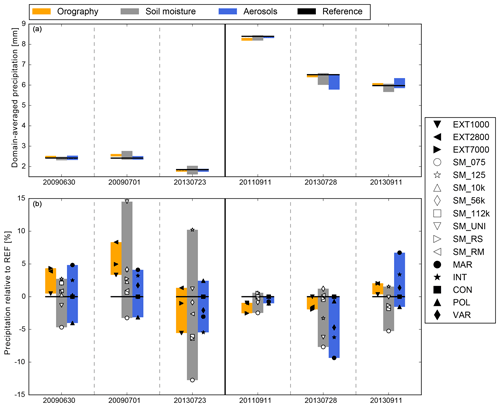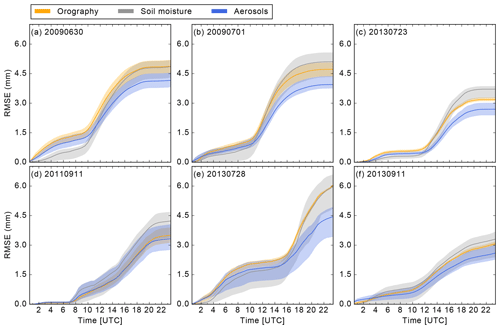Relative impact of aerosol, soil moisture and orography on convection
For the first time, the relative impact of orography, soil moisture and aerosols on precipitation over Germany was analyzed for different weather regimes.
|
How well we can predict convective precipitation depends on many factors, such as the large-scale flow, the geographical region (i.e., the presence of mountains), and land surface–atmosphere as well as aerosol–cloud interactions. In a new publication, we address all these factors by investigating their relative impact for precipitation over Germany in different weather regimes. We conduct numerical sensitivity studies with the COnsortium for Small-sale MOdelling (COSMO) model: (i) smoothing of topographical features, (ii) changes in the soil moisture fields and (iii) changes in the aerosol concentration.
 Our results in Fig. 1 show that the impact of these perturbations on precipitation is on average higher for weak (high pressure regimes) than for strong synoptic forcing (low pressure regimes). Soil moisture and aerosols are each responsible for the maximum precipitation response for three of the cases, while the sensitivity to terrain forcing always shows the smallest spread. For the majority of the analyzed cases, the model produces a positive soil moisture–precipitation feedback (i.e. more precipitation for wetter soils). Furthermore, the amount of soil moisture affects precipitation more strongly than its spatial distribution. The precipitation response to changes in the CCN concentration is more complex and case dependent. The smoothing of terrain shows weaker impacts on days with strong synoptic forcing because surface fluxes are less important and orographic ascent is still simulated reasonably well, despite missing fine-scale orographic features. Our results in Fig. 1 show that the impact of these perturbations on precipitation is on average higher for weak (high pressure regimes) than for strong synoptic forcing (low pressure regimes). Soil moisture and aerosols are each responsible for the maximum precipitation response for three of the cases, while the sensitivity to terrain forcing always shows the smallest spread. For the majority of the analyzed cases, the model produces a positive soil moisture–precipitation feedback (i.e. more precipitation for wetter soils). Furthermore, the amount of soil moisture affects precipitation more strongly than its spatial distribution. The precipitation response to changes in the CCN concentration is more complex and case dependent. The smoothing of terrain shows weaker impacts on days with strong synoptic forcing because surface fluxes are less important and orographic ascent is still simulated reasonably well, despite missing fine-scale orographic features.
|

Compared with the reference simulation, the root mean square error (RMSE) of total precipitation is generally largest for the times with maximum precipitation rates (Fig. 2). For the weak forcing cases, orography and aerosol modifications lead to larger RMSE values already for smaller rain rates in the early morning hours than the soil moisture runs. Overall, the errors are largest in the soil moisture and orography runs and smallest in the aerosol runs. We also find that the spread at the end of the simulation of the aerosol runs is always higher for strong than for weak synoptic forcing, which points to a larger role of CCN concentrations in this weather regime. The same holds true for the soil moisture runs, which also have the largest spreads of all sensitivities studied here.
Our results suggest that for quantitative precipitation forecasting, both aerosols and soil moisture are of similar importance and that their inclusion in convective-scale ensemble forecasting containing classical sources of uncertainty should be assessed in the future.
|
|
Reference: Schneider, L., Barthlott, C., Hoose, C., and Barrett, A. I.: Relative impact of aerosol, soil moisture, and orography perturbations on deep convection, Atmos. Chem. Phys., 19, 12343–12359, https://doi.org/10.5194/acp-19-12343-2019, 2019.
|
